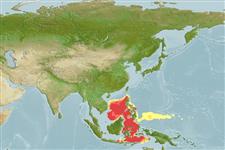Teleostei (teleosts) >
Beryciformes (Sawbellies) >
Cetomimidae (Flabby whalefishes)
Etymology: Cetomimoides: Greek, ketos = a marine monster, whale + Greek, mimos, -ou = imitator + Suffix, Greek,oides = similar to (Ref. 45335).
Eponymy: Albert Eide Parr (1900–1991) was a Norwegian-born zoologist, oceanographer and innovative museum director. [...] (Ref. 128868), visit book page.
Environment: milieu / climate zone / depth range / distribution range
Ecology
Marine; pelagic-oceanic. Tropical
Western Central Pacific: Philippines.
Size / Weight / Age
Maturity: Lm ? range ? - ? cm
Max length : 3.7 cm SL male/unsexed; (Ref. 35731)
All known specimens are males.
Life cycle and mating behavior
Maturity | Reproduction | Spawning | Eggs | Fecundity | Larvae
Paxton, J.R., 1999. Megalomycteridae. Bignose fishes. p. 2209. In K.E. Carpenter and V.H. Niem (eds.) FAO species identification guide for fishery purposes. The living marine resources of the WCP. Vol. 4. Bony fishes part 2 (Mugilidae to Carangidae). FAO, Rome. (Ref. 9844)
IUCN Red List Status (Ref. 130435: Version 2024-1)
Threat to humans
Harmless
Human uses
Fisheries: of no interest
Tools
Special reports
Download XML
Internet sources
Estimates based on models
Phylogenetic diversity index (Ref.
82804): PD
50 = 1.0000 [Uniqueness, from 0.5 = low to 2.0 = high].
Bayesian length-weight: a=0.00389 (0.00180 - 0.00842), b=3.12 (2.94 - 3.30), in cm total length, based on all LWR estimates for this body shape (Ref.
93245).
Fishing Vulnerability (Ref.
59153): Low vulnerability (10 of 100).
